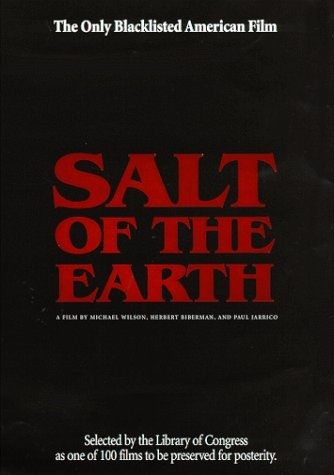| |
 |
Title: Salt of the Earth
| Genre: Drama, History |
Year: 1954 |
Country: USA |
Rating:  |
Starring: Will Geer, David Wolfe, Mervin Williams, David Sarvis, Rosaura Revueltas
|
Director: Herbert J. Biberman
|
My Review: This B&W movie was produced in 1954 - at the height of the 'McCarthy' communism witch-hunts - Directed and produced by film industry professionals (members of the original 'Hollywood Ten') who had already been blacklisted (because of their communist affiliations/refusing to testify (on First Amendment grounds) in congressional hearings (House Committee on Un-American Activities)) by all the big studios. The producers created their own film company, used their own funds, and cast real miners/members of the community to act in this film. The story is a tragic but true tale about the exploitation of workers, racial bigotry, sexism and corporate greed. All subjects shunned by major studios. A politically charged story about unsafe conditions, unfair treatment, and a strike at the 'Empire Zinc' mine in New Mexico (actual events took place in 1951). Mexican American workers are treated like slaves by the corporation that owns the mine, the company store, and the workers homes. When one too many accidents, and lax safety measures results in the death of yet another worker, the miners go on strike. Striking for wage equality (with Anglo workers), safer conditions (in the mines) and better sanitation (in their homes), the men and women of this company town take on their corporate bosses in a fight for their lives, their rights and human dignity. The neo-realist film style, and narrated drama was extremely well done. The non-professional actors were clearly doing their best. Vested in the authentic feel, and emotional currency of the film. The film tackles immense social issues, portrays the prejudice of ignorance, the corruption of corporate greed and solidarity of union workers united in a just cause. Crossing multiple social lines, challenging the film industry, defying congressional pogroms, promoting equal rights, civil rights, women's rights and other social issues. Despite the amateur acting (four cast members were professional actors), and less than perfect cinematography, this historic movie is well worth watching. With messages that rise far above it's flaws, this movie is listed in the library of congress as one of the top 100 most important and influential U.S. made films. The film was denounced by US House of Representatives for its communist sympathies, the FBI investigated the film's financing, the American Legion called for a nation-wide boycott, film processing labs were told not to work on the film, unionized projectionists were instructed not to show it. After opening in New York City, it wasn't shown for nearly 10 years because American theaters (aside from a dozen or so) wouldn't show it. During shooting and production, the cast and crew were threatened daily. Rifle shots were fired at the set by anti-communist vigilantes. The leading lady (a paid actor) was deported to Mexico during filming. A small airplane frequently buzzed the set in an attempt to disrupt production. I give it a 5 out of 5.
Summary: Based on an actual strike against the Empire Zinc Mine in New Mexico, the film deals with the prejudice against the Mexican-American workers, who struck to attain wage parity with Anglo workers in other mines and to be treated with dignity by the bosses. The film is an early treatment of feminism, because the wives of the miners play a pivotal role in the strike, against their husbands wishes. In the end, the greatest victory for the workers and their families is the realization that prejudice and poor treatment are conditions that are not always imposed by outside forces. This film was written, directed and produced by members of the original "Hollywood Ten," who were blacklisted for refusing to answer Congressional inquiries on First Amendment grounds.
|
|
